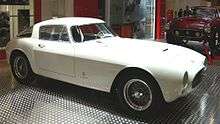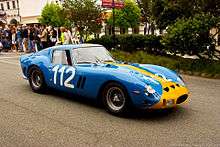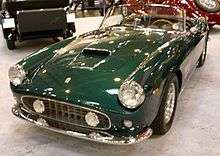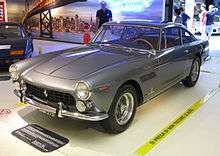Ferrari 250
| Ferrari 250 | |
|---|---|
 1962 Ferrari 250 GT/E | |
| Overview | |
| Manufacturer | Ferrari |
| Production | 1953–1964 |
| Designer |
Giotto Bizzarrini Sergio Scaglietti Pininfarina Vignale Ghia |
| Body and chassis | |
| Class | Grand Tourer |
| Body style |
Berlinetta cabriolet coupé |
| Layout | FR layout |
| Powertrain | |
| Engine | 3.0 L V12 |
| Transmission |
5-speed manual 4-speed manual |
| Dimensions | |
| Wheelbase |
2,400 mm (94.5 in)(SWB) 2,600 mm (102.4 in)(LWB) 2,800 mm (110.2 in)(Europa) |
| Chronology | |
| Successor | Ferrari 275/Ferrari 330 |
The Ferrari 250 is a sports car built by Ferrari from 1953 to 1964. The company's most successful early line, the 250 series included several variants. It was replaced by the 275 and the 330.
Similarities

Most 250 road cars share the same two wheelbases, 2,400 mm (94.5 in) for short wheelbase (SWB) and 2,600 mm (102.4 in) for long wheelbase (LWB). Most convertibles used the SWB type.
Nearly all 250s share the same Colombo Tipo 125 V12 engine. At 2,953 cc (180 cu in), it was notable for its light weight and impressive output of up to 300 PS (221 kW; 296 hp) in the Testa Rossa and GTO. The V12 weighed hundreds of pounds less than its chief competitors — for example, it was nearly half the weight of the Jaguar XK straight-6.[1] Ferrari uses the displacement of a single cylinder as the model designation.
The light V12 propelled the small Ferrari 250 racing cars to numerous victories.
Racing models
Typical of Ferrari, the Colombo V12 made its debut on the race track, with the racing 250s preceding the street cars by three years.
225 S
A predecessor to the 250 line was the 225 S introduced at the 1952 Giro di Sicilia. Two of the two-seat sports prototypes were built, an open barchetta and closed coupé, both by Vignale. Seven 225 S cars were entered in the 1952 Mille Miglia, but they were overshadowed by the larger-engined 250 S. A 225 S tested at Imola was the first Ferrari to drive the course.
250 S
The first 250 was the experimental 250 S berlinetta prototype entered in the 1952 Mille Miglia for Giovanni Bracco and Alfonso Rolfo. The Mercedes-Benz 300SL racers of Rudolf Caracciola, Hermann Lang, and Karl Kling were faster on the long straights but the 230 PS (169 kW; 227 hp) Ferrari made up sufficient ground in the hills and curves to win the race. The car was later entered at Le Mans and in the Carrera Panamericana.
The 250 S used a 2,250 mm (88.6 in) wheelbase with a "Tuboscocca" tubular trellis frame. Suspension was by double wishbones at the front, with double longitudinal semi-elliptic springs locating the live axle at the rear. The car had the drum brakes and worm-and-sector steering typical of the period. The dry-sump 3.0 L (2,953 cc (180 cu in)) engine used three Weber 36DCF carburettors and was mated directly to a five-speed manual transmission.
250 MM
_(cropped).jpg)
Following the success of the 250 S in the Mille Miglia, Ferrari showed a more conventional chassis for the new 250 engine at the 1952 Paris Motor Show. Pinin Farina then created coupé bodywork which had a small grille, compact tail and panoramic rear window, and the new car was launched as the 250 MM (for Mille Miglia) at the 1953 Geneva Motor Show. Carrozzeria Vignale's open barchetta version was also an innovative design whose recessed headlights and side vents became a Ferrari staple for the 1950s.
The 250 MM's wheelbase was longer than the 250 S at 2,400 mm (94.5 in),[2] with the coupé 50 kg (110 lb) heavier than the 850 kg (1,874 lb) barchetta. The V12 engine's dry sump was omitted from the production car, and the transmission was reduced by one gear. Power was increased to 240 PS (177 kW; 237 hp). The four-cylinder 625 TF and 735 S replaced the V12-powered 250 MM later in 1953.
The 250 MM's race debut was at the 1953 Giro di Sicilia with privateer Paulo Marzotto. A Carrozzeria Morelli-bodied 250 MM barchetta driven by Clemente Biondetti came fourth in the 1954 Mille Miglia.
250 Monza
The 1954 250 Monza was and unusual hybrid of the light four-cylinder 750 Monza and the 250 line. The model used the 250 engine in the short-wheelbase chassis from the 750 Monza. The first two used the Pininfarina barchetta shape of the 750 Monza and a one-off 500 Mondial. Two more 250 Monzas were built by Carrozzeria Scaglietti, an early use of the now-familiar coachbuilder. Although a frequent entrant through 1956, the 250 Monzas failed to gain much success and the union of the Monza chassis and 250 engine was not pursued beyond this model.
250 Testa Rossa
- See main article Ferrari TR
The racing 250 Testa Rossa was one of the most successful Ferrari racing cars in its history, with three wins at Le Mans, four wins at Sebring, and two wins at Buenos Aires. One example sold at auction for a record-breaking $16.39 million.
250 GTO

- See main article Ferrari 250 GTO
The 250 GTO was produced from 1962 to 1964 for homologation into the FIA's Group 3 Grand Touring Car category. GTO stands for "Gran Turismo Omologato", Italian for "Homologated Grand Tourer". When new, the GTO sold for $18,500 in the United States, and buyers had to be personally approved by Enzo Ferrari and his dealer for North America, Luigi Chinetti.
In May 2012, the 1962-1964(1963) Ferrari 250 GTO chassis number 3505GT sold by an auction for US$38,115,000.
In October 2013, the 1962-1964(1963) Ferrari 250 GTO chassis number 5111GT sold by Connecticut-based collector Paul Pappalardo to an unnamed buyer in a private transaction for US$52 million.
Thirty-six cars were made in 1962 and 1963. In 1964 the Series II was introduced, which had a different body. Three such cars were made, and four older Series I cars were given a Series II body. It brought the total number of GTOs produced to 39.
In 2004, Sports Car International placed the 250 GTO eighth on a list of Top Sports Cars of the 1960s, and nominated it the top sports car of all time. Motor Trend Classic placed it first on a list of the "Greatest Ferraris of all time".
250 P

The 250 P was a Prototype racer produced in 1963, winning that year's 12 Hours of Sebring, 1000 km Nürburgring and the 24 Hours of Le Mans. The 250 engine from the Testa Rossa was mounted amidships for the 250 P prototype racer of 1963.
250 LM
The mid-engined 250 Le Mans looked very much the prototype racer but was intended for production as a road-going GT. Descended from the 250 P, the Le Mans also appeared in 1963 and sported Pininfarina bodywork. Ferrari was unable to persuade the FIA that he would build the 100 examples required to homologate the car for GT racing. Eventually, 32 LMs were built[3] up to 1965. As a result, Ferrari withdrew from factory participation in the GT class of the 1965 World Sportscar Championship, allowing the Shelby Cobra team to dominate. Only the very early LM's were true 250 models. All the others made as 3300cc models, and as such should have been named 275 LM. The early cars were converted to the 3300cc engine.
250 Export/Europa
The 1953 250 Export and Europa were the only ones of the family to use a different engine, sharing the 2953 cc Lampredi V12 designed for Formula One. 185VR16 Pirelli Cinturato CA67 tyres were standard on both versions.
250 Export
The 250 Export was similar to the 250 MM with its 2,400 mm (94.5 in) wheelbase. It had a 220 PS (162 kW; 217 hp) Lampredi engine, and was launched at the Paris Motor Show of 1953.
250 Europa
The 250 Europa, also introduced in Paris in 1953, looked entirely different. With the long 2,800 mm (110.2 in) wheelbase and Ferrari America-style bodies, it was designed as more of a grand tourer than any previous 250. Both Pininfarina and Vignale handled the coachwork, and 21 were made.
GT cars
The 250 design was successful both on the road and on the track. A number of GT models were built in varying states of road or racing trim.
250 Europa GT
The first road car to use Colombo's 250 V12 was the 250 Europa GT, introduced at the 1954 Paris Motor Show. Pinin Farina's sober Paris coupé was just one of many shapes for the 250 GT model line, with coachbuilt production extending through 1956 before the 250 line became more standardized. The original 250 Europa GT used a 2,600 mm (102.4 in) wheelbase on a conventional chassis, with Pirelli Cinturato 185VR16 tyres (CA67). The dry sump V12 was tuned to 220 PS (162 kW; 217 hp), with three Weber 36DCZ3 carburettors. Echoing Vignale's 250 Europa, Pinin Farina added now-familiar vents to the front fenders, a standard styling cue for many of the 250 GTs that followed.
250 GT Boano and Ellena
_Ferrari_250_GT_Boano%2C_low-roof_all-alloy_Berlinetta.jpg)
Pinin Farina introduced a 250-based prototype at the 1956 Geneva Motor Show which came to be called the 250 GT Boano. Intended as a styling exercise and inspiration to 250 GT Europa customers, the car generated demand that soon called for a production series.
Unable to meet the demand without expansion, Pinin Farina asked Mario Boano, formerly of Ghia, to handle the construction. When Fiat later recruited Boano, he handed production duties to his son-in-law Ezio Ellena. With partner Luciano Pollo, Carrozzeria Ellena would produce the 250 GT for another few years. Ellena revised the car, raising the roof and removing the vent windows from the doors. These examples became known as the 250 GT Ellena.
Carrozzeria Boano built 74 250 GTs on the long-wheelbase chassis. Carrozzeria Ellena built another 50 Coupés.
All but one were coupés. The single convertible, 0461 GT, was sold to New York collector Bob Lee off the stand at the 1956 New York Auto Show. At the direction of Enzo Ferrari, Lee bought the car for $9,500, far below cost. He still owns it, making it one of the oldest Ferraris still in the hands of the original purchaser.
250 GT Pininfarina Coupé Speciale
Four examples of the 250 GT Coupé Speciale were made, on the type 513 chassis. (Although chassis numbers were in the middle of the Boano 250 GT Coupé run they did not share the same chassis type.). They had Series I 410 Superamerica-style bodies and type 128, 3.0 V12 engines.
250 GT Berlinetta "Tour de France"
.jpg)
The 250 GT Berlinetta, nicknamed the "Long Wheelbase Berlinetta", was also called the "Tour de France" after competing in the 10-day Tour de France automobile race. Seventy-seven Tour de France cars were built,[4] of which a number were sold for GT races from 1956 through 1959. Construction was handled by Carrozzeria Scaglietti based on a Pinin Farina design. The engine began at 240 PS (177 kW; 237 hp) but eventually rose to 260 PS (191 kW; 256 hp). Pirelli Cinturato 165R400 tyres (CA67) were standard.
At the 1956 Geneva Motor Show, Scaglietti displayed their own 250 GT prototype, which became known as the limited-production, Series I, "no-louvre" 250 GT Berlinetta. The first customer car was built in May 1956, with production now the responsibility of Scaglietti in Modena. Fourteen "no-louvre" and nine "14-louvre" Series I and II Berliettas were made.
There were four series of 250 GT Berlinettas. In mid-1957 the Series III cars were introduced, with three louvres and covered headlights. Eighteen were produced. The 36 Series IV cars; retained the covered headlights and had a single vent louvre. Zagato also made five "no-louvre" superlight cars to Ugo Zagato's design.[5]
250 GT Cabriolet Pininfarina Series I

Released at Geneva in 1957, the original 250 GT Cabriolet Pininfarina Series I used the 2,600 mm (102.4 in) wheelbase and the body was styled differently from the Berlinetta. Cars left the factory on either 165R400 or 185VR16 Pirelli Cinturato tyres (CA67).
About 36 examples were produced before a second series was shown at Paris in 1959. These later cars had more in common with the production Berlinetta.
About 200 of the Series II cars were built.
Motor Trend Classic placed the 250 GT Series I Cabriolet and Coupé ninth on their list of the ten "Greatest Ferraris of all time".
250 GT California Spyder LWB

Designed for export to North America, the 1957 250 GT California Spyder was Scaglietti's interpretation of an open-top 250 GT. Aluminium was used for the hood, doors, and trunk lid, with steel elsewhere for most models. Several aluminium-bodied racing versions were also built. The engine was the same as in the 250 Tour de France racing car with up to 240 PS (177 kW; 237 hp). All used the long 2,600 mm (102.4 in) chassis, and Pirelli Cinturato 185VR16 tyres (CA67) were standard.
A total of fifty LWBs were made before the SWB version superseded them in 1960. One example sold at auction on August 18, 2007 in Monterey, California for $4.9 million.
250 GT Coupé Pininfarina
Needing series production to stabilize his company's finances, Enzo Ferrari asked Pininfarina to design a simple and classic 250 GT coupé. After the 250 GT Boano/Ellena, Pininfarina's Grugliasco plant expanded and now had the capacity to produce the new 250 GT Coupé Pininfarina. It was introduced at Milan in 1958, and 335 near-identical examples were built by 1960. Buyers included Prince Bertil of Sweden. The GT Coupé eschewed the fender vents for simple, clean lines and a notchback look with panoramic rear window. The oval grille was replaced by a more traditional long narrow look with protruding headlights. Telescopic shock absorbers were also fitted instead of the Houdailles on previous 250s, and disc brakes were added in 1960. The original 165R400 Pirelli Cinturato tyres (CA67) were later changed to 185VR16. The final 250 GT Coupé had a Superfast tail and was shown at the 1961 London Motor Show.
250 GT Berlinetta "Interim"
in 1959, seven 250 GT Berlinetta "Interim" LWB coupés were made. They utilized the old long-wheelbase chassis and had the new Pinin Farina bodywork of the upcoming SWB Berlinettas. The bodies are all-aluminum. Interim vehicles have an additional rear quarter window, absent from the succeeding "Passo Corto" Berlinettas. The Interim vehicles are serial numbers 1377GT, 1461GT, 1465GT, 1509GT, 1519GT, 1521GT and 1523GT.
250 GT Cabriolet Pininfarina Series II

In line with the high-volume coupé, Pinin Farina also designed a plainer 250 GT Cabriolet for series production. Introduced at the 1959 Paris Motor Show, the GT Spider sported a look similar to the GT Coupé of the previous year, including the removal of the side vents. 185VR15 Pirelli Cinturato tyres (CA67) were standard. On the Coupé the headlights were uncovered. About 212 were produced.
250 GT Berlinetta SWB

One of the most notable GT racers of its time, the 1959 250 GT Berlinetta SWB used a short (2,400 mm (94.5 in)) wheelbase for better handling. Of the 176 examples built, both steel and aluminum bodies were used in various road ("lusso") and racing trims. Engine output ranged from 240 PS (177 kW; 237 hp) to 280 PS (206 kW; 276 hp). The "lusso" road car version was originally fitted with 185VR15 Pirelli Cinturato (CA67).

Development of the 250 GT SWB Berlinetta was handled by Giotto Bizzarrini, Carlo Chiti, and young Mauro Forghieri, the same team that later produced the 250 GTO. Disc brakes were a first on a Ferrari GT, and the combination of low weight, high power, and well-sorted suspension made it competitive. It was unveiled at the Paris Motor Show in October and quickly began selling and racing. The SWB Berlinetta won Ferrari the GT class of the 1961 Constructor's Championship.
In 2004, Sports Car International placed the 250 GT SWB seventh on a list of Top Sports Cars of the 1960s, and Motor Trend Classic placed it fifth on a list of the ten "Greatest Ferraris of all time".
250 GT California Spyder SWB

In 1959 Ferrari gave the 250 GT Berlinetta sharper handling, reducing its wheelbase from 2,600 mm to 2,400 mm. In 1960 Scaglietti revealed the 250 GT California Spyder SWB at Geneva, its body pulled more tautly over this updated chassis. Like the 250 GT Berlinetta SWB on which it was based, the revised Spyder also received disc brakes and a 280 PS (206 kW; 276 hp) version of the three-litre V12. It was fitted with 185VR15 Pirelli Cinturato tyres (CA67). About 55 were built.
A fiberglass-bodied replica of a 1961 250 GT Spyder California, based on an MG, was featured in the 1986 film Ferris Bueller's Day Off.[6]
A 1961 SWB example that had been owned by James Coburn was sold for £5.5 million to radio DJ, Chris Evans.[7][8][9][10]
A barn find 1961 SWB formerly owned by French actor Alain Delon while he was making the film "Les Felins" with Jane Fonda sold for US$15.9 million in February 2015.[11]
On March 11, 2016 at the Omni Amelia Island Plantation, a 1961 SWB sold for US$17.16 million at auction.[12]
250 GT/E

The LWB 250 GT theme was expanded with the 2+2 model 250 GT/E, the first large-production four-seat Ferrari (earlier four-seaters were made in very small numbers). Interior space was increased by moving the engine forward in the chassis. The rear seats were suitable for children but small for adults. Pirelli Cinturato 185VR15 tyres (CA67) were original equipment.
Engine output was listed at 240 PS (177 kW; 237 hp).
Almost 1,000 GT/Es were constructed by Pininfarina with prototypes starting in 1959 and continuing through three series until 1963. The model was followed by the visually similar 330 Americas.
The large production run of the GT/E was a major contributor to Ferrari's financial well-being in the early 1960s. MSRP of the GT/E was $11,500.
A 250 GT/E can be seen in The Wrong Arm of the Law, a film starring Peter Sellers.
250 GT Berlinetta Lusso

Pinin Farina updated the 250 GT with the GT Lusso or GTL. Introduced at the 1962 Paris show, the car had flowing lines and a fastback shape typical of the GT cars of the mid-1960s. The engine was the 250 GTO's Tipo 168 with 240 hp (179 kW; 243 PS) and three Weber 36DCS carburettors. 185VR15 Pirelli Cinturato tyres (CA67) were standard.
Built by Scaglietti, the Lusso continued through 1964 with few modifications.
Rock star Eric Clapton owned one, and an example that had been owned by Steve McQueen sold at auction for $2.3 million on 16 August 2007.[13]
A replica of the 250 GT Lusso "... owned by Steve McQueen ..." was featured in the 2011 film Tower Heist.
In 2004, Sports Car International placed the 250 GT Lusso tenth on a list of Top Sports Cars of the 1960s. Steve Boone, a member of the Rock and Roll Hall of Fame with the group Lovin' Spoonful owned chassis number #4237, which was stolen from a repair shop in Queens, New York and never found, .
330 America

A 250 in all but name, the 1963 330 America shared the outgoing model's chassis but not its engine. Powered by the new 4.0 L engine of the later 330 cars, fifty 330 Americas were built. 185VR15 Pirelli Cinturato tyres (CA67) were original equipment, changed to 205VR15s (CN72) after 1964. A famous 330 America was that of California socialite Sandra Ilene West, who was buried at the wheel of the car following a 1977 drug overdose. Her instructions specified that she be clad in her lace nightgown with the driver’s seat "slanted at a comfortable angle". Car and driver are interred at the Alamo Masonic Cemetery, San Antonio, Texas.[14]
Place in Lamborghini history
Tractor manufacturer Ferruccio Lamborghini owned several Ferrari 250s. His frustration with Enzo Ferrari's response to his complaints about frequent clutch problems was key to his decision to make his own cars.[15] He later hired ex-Ferrari engineers to design and develop them.[16]
See also
- Ferrari 250 GT Drogo - the "Breadvan", a 250 SWB modified by Giotto Bizzarrini and Piero Drogo for Giovanni Volpi.
References
- ↑ "Dave Williams' Engine Weight Chart". Archived from the original on November 13, 2004. Retrieved July 25, 2006.
- ↑ "Ferrari 250 MM". Ferrari GT - en-EN. Retrieved 2015-12-11.
- ↑ "Ferrari 250 LM". UltimateCarPage.com. Retrieved 2011-09-28.
- ↑ Ahlgrim, Steve (November 2012). "1956 Ferrari 250 GT LWB TdF". Sports Car Market. 24 (11): 34–35.
- ↑ "1958 Ferrari 250 GT LWB 'Tour de France' Berlinetta". RM Auctions. Retrieved 2012-11-11.
- ↑ IMDB. "Ferris Bueller's Day Off - Trivia". Retrieved 2009-01-29.
- ↑ Pollard, Tim (2008-05-19). "Chris Evans buys Ferrari 250 GT California for £5m". Car Magazine. Retrieved 2008-05-24.
- ↑ English, Andrew (2008-05-19). "Chris Evans pays £5m for vintage Ferrari". The Telegraph. Retrieved 2008-05-24.
- ↑ "King of the road: Chris Evans splashes out £5.5m on James Coburn's 1961 Ferrari". Daily Mail. 2008-05-19. Retrieved 2008-05-21.
- ↑ Phillips, Drew. ""1961 Ferrari California Spyder sells for record $10,894,900" retrieved: 19 August 2008". Autoblog.com. Retrieved 2011-09-28.
- ↑ "Barn find Ferrari sells for $16 million". Retrieved February 6, 2015.
- ↑ "Sold! Ferrari Fetches Over $17 Million at Amelia Island Auction". Retrieved March 12, 2016.
- ↑ ""McQueen's Ferrari sells for $2.3 m" retrieved: 17 August 2007". BBC News. 2007-08-17. Retrieved 2011-09-28.
- ↑ http://www.findagrave.com/cgi-bin/fg.cgi?page=gr&GSln=West&GSfn=Sandra&GSbyrel=in&GSdy=1977&GSdyrel=in&GSob=n&GRid=14005057&
- ↑ Copy of Interview with Ferruccio Lamborghini, page 2
- ↑ "Modern Classic: Lamborghini 350 GT". Valvoline.com. Retrieved 2011-09-28.
External links
- Ascerbi, Leonardo (2006). Ferrari: A Complete Guide to All Models. Motorbooks. ISBN 0-7603-2550-2.
- Buckley, Martin; Rees, Chris (1998). World Encyclopedia of Cars. London: Anness Publishing. ISBN 1-84038-083-7.
- Steve McQueen's Ferrari Races Into Christie's
| Ferrari road car timeline, 1947–1969 — next » | |||||||||||||||||||||||
|---|---|---|---|---|---|---|---|---|---|---|---|---|---|---|---|---|---|---|---|---|---|---|---|
| Type | 1940s | 1950s | 1960s | ||||||||||||||||||||
| 7 | 8 | 9 | 0 | 1 | 2 | 3 | 4 | 5 | 6 | 7 | 8 | 9 | 0 | 1 | 2 | 3 | 4 | 5 | 6 | 7 | 8 | 9 | |
| Sports | 340 MM | 375 MM | |||||||||||||||||||||
| 125 S | 166 S/ |
195 S | 212 Export | 225 S | 250 MM | 250 Monza | 250 LM | ||||||||||||||||
| 159 S | 250 S | 250 Export | 250 GTO | ||||||||||||||||||||
| Berlinetta | 250 GT "Tour de France" | 250 GT SWB | 250 GT Lusso | 275 GTB | 275 GTB/4 | 365 | |||||||||||||||||
| Coupé | 166 Inter | 195 Inter | 212 Inter | 250 Europa | 250 GT Europa | 250 GT Boano | 250 GT Ellena | 250 GT Coupé Pininfarina | 330 GTC | 365 GTC | |||||||||||||
| 2+2 | 250 GT/E | 330 GT 2+2 | 365 GT 2+2 | ||||||||||||||||||||
| Spider | 250 GT Cabriolet | 275 GTS | 330 GTS | 365 GTS | |||||||||||||||||||
| 250 GT California Spyder | |||||||||||||||||||||||
| America | 340/342 America | 375 America | 410 Superamerica | 400 Superamerica | 500 Superfast | 365 California | |||||||||||||||||